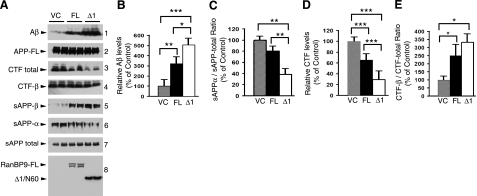Figure 6.
RanBP9-Δ1/N60 is significantly more potent than RanBP9-FL in APP processing and Aβ generation. A) HEK293FT cells were transiently cotransfected with APP751 and equal amounts of VC, RanBP9-FL (FL), or RanBP9-Δ1/N60 (Δ1) plasmids, and conditioned media and lysates were harvested 48 h after transfection when cells were fully confluent. For detection of Aβ (1), the conditioned medium was immunoprecipitated with B436 monoclonal antibody and immunoblotted with a mixture of 6E10/82E1 antibody. Conditioned media were directly immunoblotted to detect sAPP total (63G; 7), sAPP-α (6E10; 6), and sAPP-β (18957, IBL; 5). In lysates, indicated antibodies were used to detect APP-FL (CT15; 2), APP-CTF total (CT15; 3), APP-CTF-β (6E10; 4), RanBP9 (M2; 8), and D1/N60 (M2; 8). B) Densitometric quantification of Aβ showed an average of ∼3-fold increase by RanBP9-FL compared with vector control. Increase by RanBP9-Δ1/N60 was ∼5-fold, which was also significantly higher than RanBP9-FL. C) Densitometric quantification of the ratio of sAPP-α relative to sAPP total revealed significant differences between VC and Δ1/N60 and also between FL and Δ1/N60 (P<0.01). D) Densitometric quantification of total CTF levels showed significant differences between VC and FL, VC and Δ1/N60, and FL and Δ1/N60. E) Densitometric quantification of the ratio of CTF-β relative to CTF total demonstrated significant differences between VC and FL and VC and Δ1/N60. Graphs show means ± se; n = 4. *P < 0.05, **P < 0.01, ***P < 0.001; 1-way ANOVA with Student-Newman-Keuls post hoc test.

